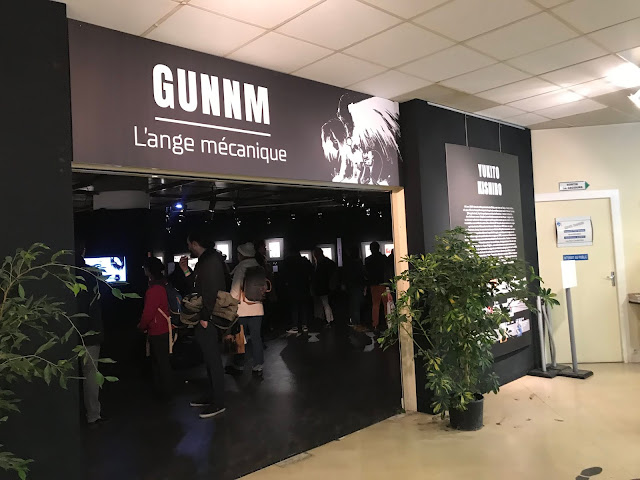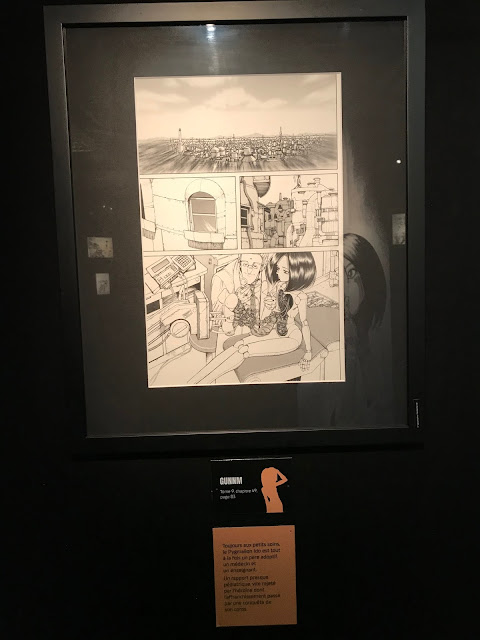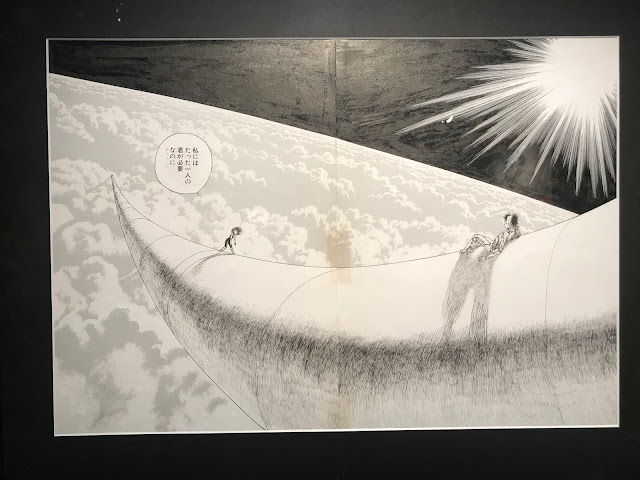The exhibition space on the main floor of the Espace Franquin served as the home to another exhibition devoted to manga, though here the focus was on a singular creation rather than an entire range of work.
Gunnm, l'ange mécanique [Gunnm, the mechanical angel] paid homage to Yukito Kishiro's popular cyberpunk series (known to North American readers as
Battle Angel Alita) that was originally serialized in Japan from 1990 to 1995, and which was one of the first wave of manga to be translated into French in 1998. To support this exhibition, the Festival pulled out all stops: showcasing 150 pages of original artwork from the series for the first time outside of Japan, as well as bringing in Yukito Kishiro himself for a masterclass and an international encounter with Enki Bilal.
Inside the darkened L-shaped exhibition room, the pages of original artwork were displayed on the walls as well as on flat and angular tables, and all are individually illuminated by ceiling spotlights. Near the entrance, visitors are drawn toward a video screen that features clips of individual interviews with Kishiro, directors James Cameron and Robert Rodriguez and producer Jon Landau talking about Gunnm the manga and its adaptation into the feature film
ALITA: BATTLE ANGEL (2019).
The exhibition organized the collection of original artwork into five separate sections that guided visitors through Kishiro's major graphic and thematic preoccupations that distinguished the series and elevated it (and by extension, its author) to stratospheric popularity.
1.
Le corps (the body). As the heroine of the series is an android named Gally, Kishiro places significant visual and thematic emphasis on the body as a site of permanent construction and destruction. Pages in this section are arranged to incrementally spotlight scenes of dismemberment, disconnection and repair to underline Kishiro's indulgence with the organo-mechanic body.
2.
L'icone Gally (Gally the icon)
Gally's identity as an android
provided Kishiro with the freedom to explore other the ways that duality is literally inscribed upon her body: human/android; hard wiring/free will; warrior/pacifist; violent/tender; and bounty hunter/prey. These dialectics consistently highlight the tension within Gally between the mechanical and the human in her search for her own humanity, with a visual character design that helps elevate her beyond being a simple character toward iconic status.
3.
Un monde d'absolu (A world of absolutes)
The action in GUNNM takes place in a universe perfectly in tune with a post-Blade Runner aesthetic, where class divisions are expressed by two worlds: Kuzutetso (the lower depths) and Zalem (the upper heights). Pages that represent each of these worlds provided stunning clarity to Kishiro's labour and his vision in mapping out the intricate details that give these environments a sense of place and scope.
4.
La cinétique (kineticism)
GUNNM is conceived and presented as a grand action spectacle. Its pages highlight Kishiro's use of speed and sport through Motorball, a violent game within the GUNNM universe. The selected pages allowed for closer viewing to demonstrate the graphic tools that Kishiro uses, such as blur lines, panel and page design to connote velocity and combat.
5.
Les mues de Yukito Kishiro (The reinventions of Yukito Kishiro). The concluding section presents an evolution of Yukito Kishiro's graphism due to his discoveries of new tools (from airbrushing to digital art) and of new international comics (especially American comics).
This is a solid exhibition with a distinct aesthetic for its presentation (black walls and frames with ceiling spotlights as light sources; thematic sections individuated with color coded captions). The text and captions are to-the-point and provide sufficient commentary for visitors to appreciate what makes this series connect with its readers. Fans of the series will devour the opportunity to see so many original pages that confirm Kishiro's mastery, while neophytes such as myself will leave with a greater appreciation of the series and its place within both Japanese and French comics history.
Nick Nguyen
All photos taken by Nick Nguyen























































